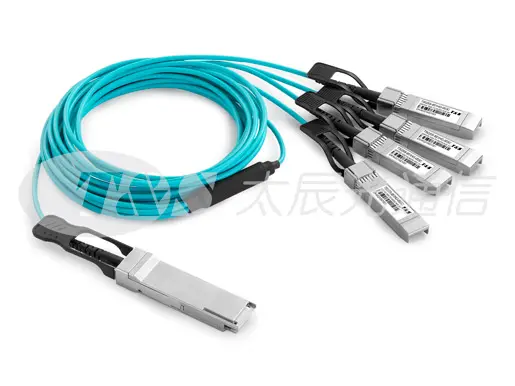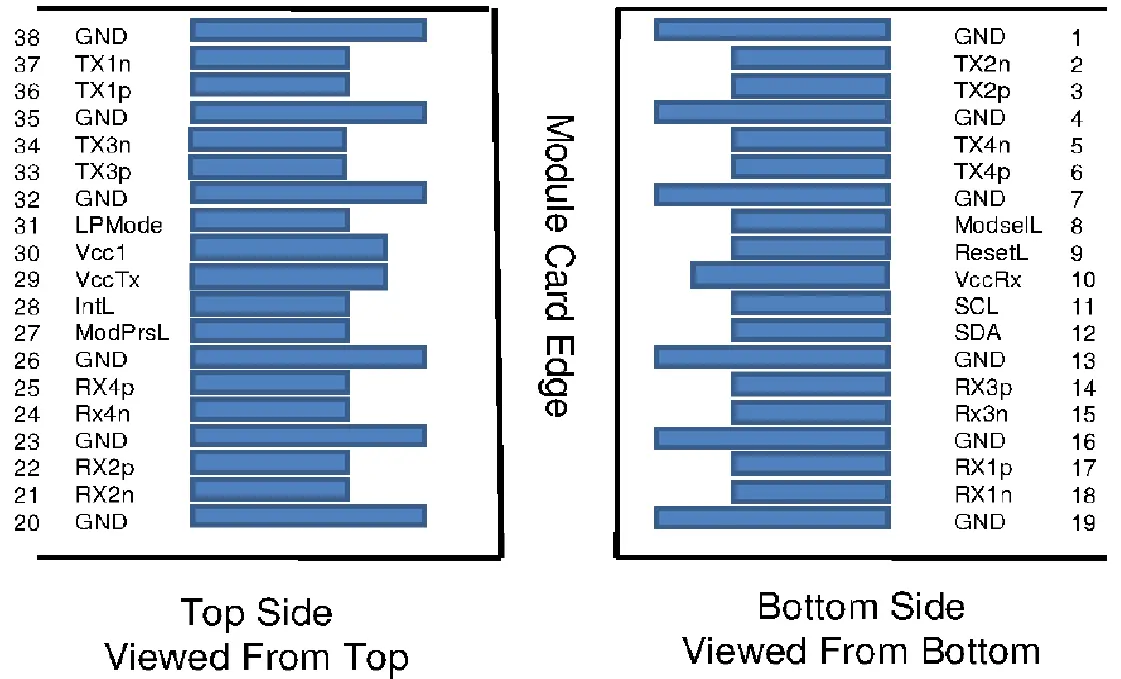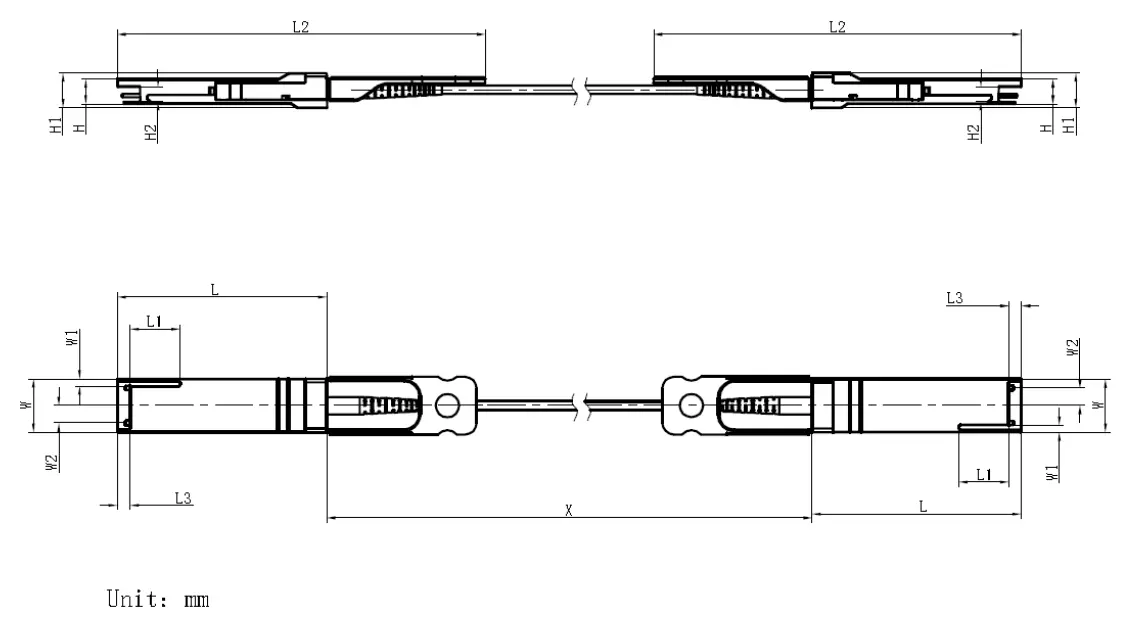
T&S Communication TSQSS-851HG-xxxC is a Four-Channel, Pluggable, Parallel, Fiber-Optic QSFP28 SR4 for 100G Ethernet applications. This transceiver is a high-performance module for short-range multi-lane data communication and interconnect applications. It integrates four data lanes in each direction with 100 Gbps bandwidth. Each lane can operate at 25Gbps up to 70 m using OM3 fiber or 100 m using OM4 fiber without FEC, or 300 m using OM4 fiber with FEC. These modules are designed to operate over multimode fiber systems using a nominal wavelength of 850nm. The electrical interface uses a 38 contact edge type connector. The optical interface uses a 12 fiber MTP (MPO) connector. As a professional AOC factory, T&S produces our 100G QSFP28 series with consistently high quality.
Electrical interface compliant to SFF-8436 and SFF-8431
850nm VCSEL laser and PIN photo-detector
Built-in digital diagnostic functions
Operating case temperature 0℃ to 70℃
Hot Pluggable
Similar to the other AOC cables produced by T&S, such as our 40G AOC, our 100G breakout AOC cable is also RoHS-compliant
100GbE and 25GbE break-out applications for Datacom switch and router connections
100G to 4×25G density applications for Datacom and Proprietary protocol applications, Datacenters
Parameter | Symbol | Min | Max | Unit |
Storage Temperature | TS | -20 | 85 | ℃ |
Relative Humidity | RH | 0 | 85 | % |
Case Operating Temperature | TCase | 0 | 70 | ℃ |
Supply Voltage | VCC | -0.3 | 3.6 | V |
Parameter | Symbol | Min | Typical | Max | Unit |
Case Operating Temperature | TCase | 0 | - | 70 | ℃ |
Supply Voltage | VCC | 3.13 | 3.3 | 3.47 | V |
Supply Current (QSFP28) | ICC | - | - | 1000 | mA |
Supply Current(SFP28) | ICC | - | - | 300 | mA |
Data Rate Per Lane | DR | - | 25.78125 | - | Gbit/s |
Measurement condition: Channel data rate 25.78125Gbps, VCC=3.3V, PRBS31 pattern, Case operating temperature 0-70℃.
Parameter | Symbol | Min | Typical | Max | Unit |
QSFP28 | |||||
Center wavelength | λc | 840 | 850 | 860 | nm |
Differential Input Impedance | Zin | 90 | 100 | 110 | Ohm |
Differential Input Voltage | Vin | 300 | - | 1100 | MVP-p |
Average Launch Power per Lane | PAVG | -7.5 | -1 | +2.5 | dBm |
Extinct Ratio | ER | 2.0 | - | - | dB |
SFP28 | |||||
Center wavelength | λc | 840 | 850 | 860 | nm |
Differential Input Impedance | Zin | 90 | 100 | 110 | Ohm |
Differential Input Voltage | Vin | 300 | - | 1100 | MVP-p |
Average Launch Power | PAVG | -7.5 | -1 | +2.5 | dBm |
Extinct Ratio | ER | 2.0 | - | - | dB |
Measurement condition: Channel data rate 25.78125Gbps, VCC=3.3V, PRBS31 pattern, Case operating temperature 0-70℃
Parameter | Symbol | Min | Typical | Max | Unit |
QSFP28 | |||||
Center wavelength | λc | 840 | 850 | 860 | nm |
Differential Output Impedance | Zout | 90 | 100 | 110 | Ohm |
Differential Output Voltage | Vout | 500 | - | 800 | MVP-p |
Receiver Overload | Pinmax | +2.5 | - | - | dBm |
Bit Error Rate | BER | - | - | 10-12 | - |
SFP28 | |||||
Center wavelength | λc | 840 | 850 | 860 | nm |
Differential Output Impedance | Zout | 90 | 100 | 110 | Ohm |
Differential Output Voltage | Vout | 500 | - | 800 | MVP-p |
Receiver Overload | Pinmax | +2.5 | - | - | dBm |
Bit Error Rate | BER | - | - | 10-12 | - |

Pin | Symbol | Name/Description |
1 | GND | Ground |
2 | Tx2n | Transmitter Inverted Data Input |
3 | Tx2p | Transmitter Non-Inverted Data Input |
4 | GND | Ground |
5 | Tx4n | Transmitter Inverted Data Input |
6 | Tx4p | Transmitter Non-Inverted Data Input |
7 | GND | Ground |
8 | ModSelL | Module Select |
9 | ResetL | Module Reset |
10 | Vcc Rx | +3.3 V Power supply receiver |
11 | SCL | 2-wire serial interface clock |
12 | SDA | 2-wire serial interface data |
13 | GND | Ground |
14 | Rx3p | Receiver Non-Inverted Data Output |
15 | Rx3n | Receiver Inverted Data Output |
16 | GND | Ground |
17 | Rx1p | Receiver Non-Inverted Data Output |
18 | Rx1n | Receiver Inverted Data Output |
19 | GND | Ground |
20 | GND | Ground |
21 | Rx2n | Receiver Inverted Data Output |
22 | Rx2p | Receiver Non-Inverted Data Output |
23 | GND | Ground |
24 | Rx4n | Receiver Inverted Data Output |
25 | Rx4p | Receiver Non-Inverted Data Output |
26 | GND | Ground |
27 | ModPrsL | Module Present |
28 | IntL | Interrupt |
29 | Vcc Tx | +3.3 V Power supply transmitter |
30 | Vcc1 | +3.3 V Power Supply |
31 | LPMode | Low Power Mode |
32 | GND | Ground |
33 | Tx3p | Transmitter Non-Inverted Data Input |
34 | Tx3n | Transmitter Inverted Data Input |
35 | GND | Ground |
36 | Tx1p | Transmitter Non-Inverted Data Input |
37 | Tx1n | Transmitter Inverted Data Input |
38 | GND | Ground |

PIN | Symbol | Name/Description |
1 | VeeT | Transmitter Signal Ground |
2 | TX_FAULT | Transmitter Fault (LVTTL-O) – Not used. Grounded inside the module |
3 | TX_DISABLE | Transmitter Disable (LVTTL-I) – High or open disables the transmitter |
4 | SDA | Two Wire Serial Interface Data Line (LVCMOS – I/O) (same as MOD-DEF2 in INF-8074) |
5 | SCL | Two Wire Serial Interface Clock Line (LVCMOS – I/O) (same as MOD-DEF1 in INF-8074) |
6 | MOD_ABS | Module Absent (Output), connected to VeeT or VeeR in the module |
7 | RS0 | Rate Select 0 - Not used, Presents high input impedance. |
8 | RX_LOS | Receiver Loss of Signal (LVTTL-O) |
9 | RS1 | Rate Select 1 - Not used, Presents high input impedance. |
10 | VeeR | Receiver Signal Ground |
11 | VeeR | Receiver Signal Ground |
12 | RD- | Receiver Data Out Inverted (CML-O) |
13 | RD+ | Receiver Data Out (CML-O) |
14 | VeeR | Receiver Signal Ground |
15 | VccR | Receiver Power + 3.3 V |
16 | VccT | Transmitter Power + 3.3 V |
17 | VeeT | Transmitter Signal Ground |
18 | TD+ | Transmitter Data In (CML-I) |
19 | TD- | Transmitter Data In Inverted (CML-I) |
20 | VeeT | Transmitter Signal Ground |

 A Comprehensive Guide to LC UPC Patch Cords
20 Dec 2024
Fiber optic technology is at the heart of modern communication networks, enabling fast, long-distance, and low-loss data transmission. Among the key components of these networks are LC UPC patch cords...
A Comprehensive Guide to LC UPC Patch Cords
20 Dec 2024
Fiber optic technology is at the heart of modern communication networks, enabling fast, long-distance, and low-loss data transmission. Among the key components of these networks are LC UPC patch cords...
 Call us on:
Call us on:  Email Us:
Email Us:  8 Jinxiu Middle Road,
8 Jinxiu Middle Road,